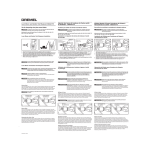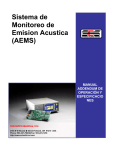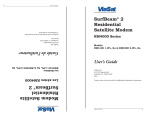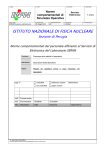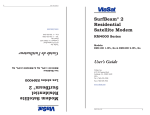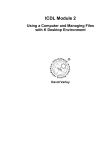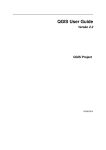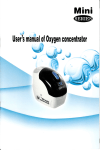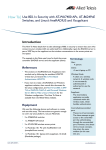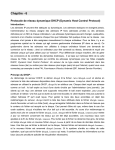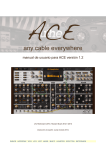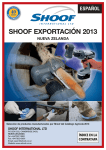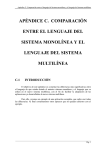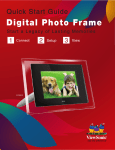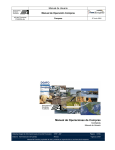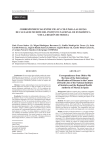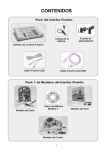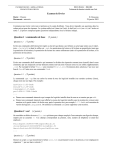Download BIF (Build It Fast)
Transcript
BIF (Build It Fast) Manual de instalación y primeros pasos Nicolás César Lucas Di Pentima Sergio Cayuqueo BIF (Build It Fast): Manual de instalación y primeros pasos por Nicolás César, Lucas Di Pentima, y Sergio Cayuqueo Copyright 2002 Nicolás César, Lucas Di Pentima. Permission is granted to copy, distribute and/or modify this document under the terms of the GNU Free Documentation License, Version 1.1 or any later version published by the Free Software Foundation; with no Invariant Sections, with no Front-Cover Texts, and with no Back-Cover Texts. A copy of the license is included in the section entitled "GNU Free Documentation License". Historial de revisiones Revisión 0.3 27 Julio 2003 Revisado por: ndc Expansion de BIF3 Revisión 0.2 Junio 2003 Revisado por: ndc Migración de BIF2 a BIF3 Revisión 0.1 01 Agosto 2002 Revisado por: ldp Migración a docbook de lo hecho en LaTeX Tabla de contenidos 1. Introducción ...........................................................................................................................................1 1.1. ¿Qué es BIF? ...............................................................................................................................1 1.2. ¿Qué NO es BIF? ........................................................................................................................1 1.3. Requerimientos ...........................................................................................................................1 1.4. Instalación desde archivos .tar.gz...........................................................................................2 1.5. Instalación desde archivos .tgz(Slackware) .........................................................................2 1.6. Instalación desde archivos .deb .................................................................................................2 1.7. Instalación para un sitio (y programadores ansiosos) .................................................................2 1.8. Instalación para múltiples sitios ..................................................................................................3 2. Cómo pensar con BIF............................................................................................................................5 2.1. Historia........................................................................................................................................5 2.2. Introducción ................................................................................................................................6 3. Creando mi sitio .....................................................................................................................................8 3.1. Configuracion de mi sitio ............................................................................................................8 3.2. Creando mis archivos ................................................................................................................10 3.3. Un ejemplo practico ..................................................................................................................10 4. Creando mis Skins ...............................................................................................................................12 4.1. Creando mi Skins personal .......................................................................................................12 4.2. Comenzando con el Skin...........................................................................................................12 5. Descripción de widgets ........................................................................................................................15 6. Creando mis widgets............................................................................................................................16 6.1. Widget Simple...........................................................................................................................16 7. Referencias ...........................................................................................................................................18 A. GNU Free Documentation License....................................................................................................19 A.1. PREAMBLE ............................................................................................................................19 A.2. APPLICABILITY AND DEFINITIONS ................................................................................19 A.3. VERBATIM COPYING...........................................................................................................20 A.4. COPYING IN QUANTITY .....................................................................................................20 A.5. MODIFICATIONS...................................................................................................................21 A.6. COMBINING DOCUMENTS.................................................................................................23 A.7. COLLECTIONS OF DOCUMENTS ......................................................................................23 A.8. AGGREGATION WITH INDEPENDENT WORKS..............................................................23 A.9. TRANSLATION ......................................................................................................................24 A.10. TERMINATION.....................................................................................................................24 A.11. FUTURE REVISIONS OF THIS LICENSE .........................................................................24 A.12. How to use this License for your documents .........................................................................24 iii Capítulo 1. Introducción 1.1. ¿Qué es BIF? BIF es un conjunto de herramientas para hacer aplicaciones web de forma simple y rápida, escrito en PHP. Separa la actividad en 3 roles: • Cargador de contenido • Diseñador Gráfico • Programador BIF 1.2. ¿Qué NO es BIF? No es ideal usar BIF siendo una sóla persona que se encarga de todos los roles. BIF está pensado para hacer aplicaciones medianas a grandes 1.3. Requerimientos BIF requiere PHP como módulo de Apache. Las distribuciones suelen incluir un paquete llamado mod_php o similar. de más está decir que Apache será necesario. Con respecto a la conexión de la Base de Datos: el módulo DB de PEAR es parte de la distribución de BIF a partir de la version 0.1.16. MySQL fue ampliamente probado, pero de seguro el resto de las bases de datos no tendría mayores inconvenientes. En teoría, cualquier Base de datos soportada por el módulo DB será soportado por BIF, sólo debe ser incorporada al directorio PEAR y realizar unas modificaciones mínimas. En Mandrake 9.1, hay que instalar: php-pear y va a pedir una opcion de instalacion; eligiendo ’apache2-mod_php’ se instalan los siguientes paquetes apache-conf-2.0.44-11mdk.i586 apache2-2.0.44-11mdk.i586 apache2-common-2.0.44-11mdk.i586 apache2-mod_php-2.0.44_4.3.1-2mdk.i586 apache2-modules-2.0.44-11mdk.i586 libapr0-2.0.44-11mdk.i586 libdb4.0-4.0.14-6mdk.i586 libphp_common430-430-11mdk.i586 libtool-1.4.3-1mdk.i586 libxmlrpc0-0.51-4mdk.i586 lynx-2.8.5-0.13mdk.dev.12.i586 php-pear-4.3.0-3mdk.noarch php-xml-4.3.0-2mdk.i586 php-xmlrpc-4.3.0-2mdk.i586 1 Capítulo 1. Introducción En el caso de usar una base de datos MySQL hay que instalar el paquete php-mysql que instalará libmysql12-4.0.11a-5mdk.i586 php-mysql-4.3.0-2mdk.i586 1.4. Instalación desde archivos .tar.gz La dirección de Downloads del proyecto es Downloads (http://www.lunix.com.ar/Bif.php?action=bif.Seleccion&s=download.bif). Allí estarán los .tar.gz e instrucciones de como bajar con CVS. 1.5. Instalación desde archivos .tgz(Slackware) La dirección de Downloads del proyecto es Downloads (http://www.lunix.com.ar/Bif.php?action=bif.Seleccion&s=download.bif). Allí estarán los .tgz, y se instalan con el comando installpkg disponible en slackware. 1.6. Instalación desde archivos .deb Para instalar desde paquetes Debian debemos utilizar el comando dpkg. Adicionando el parametro "-i bif3-version.deb", si ya teniamos una version anterior instalada, este la actualiza automaticamente. Por defecto el "$sys_dir" de BIF3 se instala en /usr/share/BIF3, e instala la documentacion en /usr/share/doc/bif3. Actualmente hay disponibles los paquetes Debian para BIF3 BIF3-site, la version disponible en formato a Debian la hora de escribir estas lineas era la "0.2.2". Los paquetes necesarios a instalar para el correcto funcionamiento son: bif3 : Core de bif3 bif3-skin : Skin para bif3, con soporte de apacheconfig para Alias /Skins /usr/share/bif3/Skins para la visualizacion correcta de las imagenes en el servidor web. Los paquetes extra pueden ser bif3-doc : Documentacion de bif3 con soporte libmenu, doc-base, y dwww bif3-site: Sitio de ejemplo del uso de bif3 Repositorio debian deb http://ihuronet.com.ar/ftp/debian/ ./ 2 Capítulo 1. Introducción 1.7. Instalación para un sitio (y programadores ansiosos) Este será una receta rápida para quienes quieren probar BIF por primera vez, en caso de hacer varios sitios con BIF conviene usar la metodología de Sección 1.8. Instrucciones paso a paso • Bajar los paquetes para una version de BIF (por ejemplo 0.1.16) • Descomprimirlos en el mismo directorio (por ejemplo /var/www/html/pruebaBIF). • Copiar bifConfig.inc.example a bifConfig.inc 1.8. Instalación para múltiples sitios BIF se divide en dos paquetes, para instalación a nivel sistema: BIF3-version.tgz y para la instalación a nivel sitio: BIF3-site-version.tgz Supongamos que usamos el directorio /usr/local/BIF para la instalación de BIF a nivel sistema. Entonces hay que descomprimir el paquete BIF3-version.tgz de la siguiente manera: maquina:~# cd /usr/local maquina:/usr/local# tar xvzf BIF3-version.tgz Si no funciona es probable que el archivo no se encuentre en el directorio. Hay que moverlo a /usr/local/BIF. Según el nivel de seguridad de la instalacion del PHP (depende la distribucion que usemos) tendremos que editar el archivo de configuración del PHP1. Hay que agregar /usr/local/BIF al «include_path»: (...) ;;;;;;;;;;;;;;;;;;;;;;;;; ; Paths and Directories ; ;;;;;;;;;;;;;;;;;;;;;;;;; include_path = "/usr/lib/php:/usr/share/bif3" (...) Listo, esto debería dejar instalado a nivel sistema, ahora vamos a hacer un sitio en el directorio /home/usuario/public_html: maquina:~$ cd /home/usuario/public_html maquina:/home/usuario/public_html$ tar xvfzp BIF-site-version.tgz 3 Capítulo 1. Introducción Recuerden que el directorio debe estar creado y contener a BIF-site-version.tgz. Para comprobar si funciona, arrancamos el apache si es que no está andando: maquina:~# /etc/init.d/httpd start En Debian y otras distribuciones: maquina:~# /etc/init.d/apache start En el caso de que apache ya estubiera corriendo igualmente hay que reiniciarlo, para que PHP tome la nueva directiva «include_path». Y si tiene configurado public_html como opción, abrimos un navegador en la dirección http://localhost/~usuari o/index.php (http://localhost/~usuario/test.first.php) y debería decir "Funciona!" Notas 1. Buscar el archivo php.ini bajo el directorio /etc. 4 Capítulo 2. Cómo pensar con BIF 2.1. Historia BIF fue creado por Lunix como una necesidad para la creación de un sistema basado en web que debía realizarse en un plazo corto. Lucas Di Pentima y Nicolás César ya tenían experiencia usando los conocidos «templates» bajo PHP y concluyeron que era una herramienta muy útil, pero que en el desarrollo de sitios grandes era inevitable duplicar código PHP y templates. Como el desarrollo era parte de un aprendizaje, se podían programar -copiar y pegar en realidad- 5 rutinas iguales hasta que nos dábamos cuenta de un BUG, que se tenía que corregir en todos los lugares donde aparecían esas rutinas1. La única salida a este problema era la centralización de dichas sentencias. Aquí planteamos varias alternativas y la que sobresalió por su simpleza es la orientación a objetos de los componentes de una página. La idea original era tener un archivo que en 10 líneas exprese todo lo que una página contiene. Algo como esto: Encabezado TituloProductos ProdNro23 Texto: El producto Número 23 es una excelente opción para el cultivo de soja. En nuestra empresa.... blah bla.. FinTexto PiedePagina Luego BIF automágicamente interpretaría todo y devolvería la página HTML deseada. Por ejemplo «Encabezado» pone el membrete de la companía y una tabla que encuadraba todo. el encabezado son aproximadamente 17 líneas de HTML. Y son las mismas 17 líneas para todas las páginas. Así surgió la idea de «Build It Fast v1.0». A esas palabras claves las denominamos «widgets»; como lo hace la mayoría de los frameworks de interfaces de usuario orientados a objetos. Y comenzamos a trabajar, pero nos dimos cuenta de que la idea era mucho más brillante de lo que pensábamos: dividía el trabajo por completo en tres roles claves. 5 Capítulo 2. Cómo pensar con BIF • El encargado de los contenidos. • El encargado de los widgets. • El encargado de las consultas SQL. Supongamos un escenario ficticio2: Lucas está como encargado de contenidos, entonces empieza a escribir: Encabezado TituloProductos (..) Mientras tanto no existe ni el «Encabezado» ni el «TituloProductos». Nicolás, encargado de los widgets, a los apurones hace un «Encabezado» y un «TituloProductos» que obviamente no serán los definitivos, permitiendo a Lucas continuar probando su trabajo (los contenidos que vaya insertando). Ahora Nicolás, tranquilo, puede hacer un diseño gráfico sobre esos items. En un esquema tradicional de trabajo, se espera que el diseñador gráfico concluya todo el diseño del sitio para empezar a llenarlo de contenido; con BIF no es necesario. En un momento determinado Lucas quiere incluir una encuesta en las páginas y pone una «votación del día»: (..) VotacionDelDia (..) que está vinculada a preguntas en una base de datos MySQL. Entonces le dice a Cristian, encargado de SQL, que haga el SQL correspondiente, que luego se incorporará al widget «VotacionDelDia», sin interrumpir el trabajo de cada uno. Lindo, ¿no?. 2.2. Introducción Seguramente para esta altura, ya tenés instalado BIF en tu sistema, estuviste explorando los archivos y no entendés para que sirven. Acá una breve reseña que sirve tanto para el paquete «BIF»: Los archivos .php que se pueden encontrar en las aplicaciones3 dividen en: 6 Capítulo 2. Cómo pensar con BIF Widgets Representan un enfoque funcional relativo a la aplicación. Inicialmente está vacío y se pueden utilizar los widgets del paquete de sistema BIF. Normalmente en el directorio widgets. Skins BIF tiene soporte de skins o pieles. Por cada widget se definen archivos templates, css y similares que dan aspecto de skins. Normalmente se ubican bajo el directorio skins. Para saber como crear un skin ver el capítulo ?? en la página ?? Configuración los archivos bifConfig.inc, mapping.txt, skins.txt. Componentes A partir de BIF3 surge un nuevo concepto llamado Componente. Son aquellos fragmentos del sistema que necesitan persistencia de estado entre páginas y su representación cambia a medida que se utilizan. Se basan la sesion y utilizan widgets para su represntacion Notas 1. En un sitio de 80 páginas web es muy común encontrar mas de 80 «foreach» que luego de la ejecución de una sentencia SQL completaban el correspondiente template. 2. Los personajes también son ficticios, cualquier coincidencia con la realidad es producto de tu imaginación 3. Digamos el paquete BIF-site 7 Capítulo 3. Creando mi sitio 3.1. Configuracion de mi sitio Para crear un sitio en BiF, se recomienda primero bajar el paquete BIF-site-version.tgz del sitio de BiF, y asi poder ver un ejemplo de un sitio basados en BiF funcionando. A continuacion se ve un ejemplo de un archivo bifconfig.inc con los valores por default. <?php /************************************************************ * bifConfig.inc Archivo de configuracion de usuario * ------------------------------------------------* * Este archivo tiene parametros especificos del usuario. * Si no esta seguro deje los valores por defecto. * ************************************************************ * comments? join [email protected] ************************************************************/ // $sys_dir es el directorio donde encontar la instalacion de BiF3. // Ejemplos: // //$sys_dir=dirname(__FILE__); // Directorio actual //$sys_dir=’/home/usuario/BIF3’; $sys_dir=’/usr/share/bif3’; // Session name should be unique for each application $bifcfg[’session_name’] = ’BIF3-site_example’; // Configuracion de la base de datos $bifcfg[’DB’][’phptype’] $bifcfg[’DB’][’host’] $bifcfg[’DB’][’port’] $bifcfg[’DB’][’socket’] $bifcfg[’DB’][’connect_type’] $bifcfg[’DB’][’auth_type’] $bifcfg[’DB’][’user’] $bifcfg[’DB’][’password’] $bifcfg[’DB’][’database’] = = = = = = = = = ’mysql’; // base de datos soportada por PEAR ’localhost’; // Host de la base de datos ”; // Puerto de la BD, dejar en blanco por defecto ”; // Path to the socket - leave blank for default ’tcp’; // How to connect to MySQL server (’tcp’ or ’s ’config’; // Authentication method (config, http or cook ’usuario’; // Usuario ’password’; // Password ’basededatos’; // Nombre de la BD /* * AUTHENTICATION! $bifcfg[’Auth’][’param’] = "mysql://user:password@localhost/table"; $bifcfg[’Auth’][’table’] = "auth"; */ 8 Capítulo 3. Creando mi sitio // Where the application it’s going to be executed. $app_dir=dirname(__FILE__); $bifcfg[’Skin’][’file’] = "$app_dir/skins.txt"; // Archivo de configuracion del Skin /************************************************************ ************* End of user setup *************** ************************************************************/ // Where the application it’s going to be executed. $app_dir=dirname(__FILE__); include_once("$sys_dir/Base/Bif.php"); // execute component action (in case there is one, of course) $_SESSION[’_BifApplication’]->execAction(); ?> Luego de ver esto nos damos cuenta de que debemos configurar el directorio en donde esta instalado el sistema BiF, el acceso a bases de datos, opcionalmente pero no necesario el nombre de sesion, el archivo que contiene la configuracion de los Skins que por defecto se encuentra en el directorio root del sitio, por ejemplo /var/www/misitio/skin.txt. # *********************************************************** # archivo ’skins.txt’: Archivo de configuracion de ususario # --------------------------------------------------------# En este archivo se configuran los Skins de la aplicacion # # This file has skins configuration. # They are listed in order to be included. # must exist either # "$sys_dir/Skins/$skin.php" # or # "$app_dir/Skins/$skin.php" # # *********************************************************** # comments? join [email protected] # *********************************************************** #Skins disponibles hasta la fecha SkinDefault #SkinLinuxVa #SkinLinuxV #SkinAqua #SkinGleducar #SkinFSM #SkinAvina 9 Capítulo 3. Creando mi sitio #SkinLunix #SkinIhuro Como ven en este archivo se guarda la configuracion del Skin a utilizar en nuestro sitio BiF, el formato del archivo es muy simple, los que esta despues de los # es un comentario, y para indicar las Skin a usar se indica anteponiendo el texto Skin y el nombre de la Skin, por ejemplo si mi Skin se llama LinuxVa, entonces debere poner SkinLinuxVa. Ademas la skins son anidables, o sea que si me faltan templates por hacer para algun widget entonces BIF3 los buscara por orden de busqueda. O sea que en la Skin que ponga primero BIF3 buscara los que hay en ella para completar lo que falta en la ultima. 3.2. Creando mis archivos Para comenzar a trabajar con BiF, podemos utilizarlo como una libreria para nuestros archivos PHP y ejecutar las funciones y clases desde nuestros archivos .php unicamente, ó ordenarle a nuestros scripts que procesen archivos en XML, lo cual simplifica aún mas la tarea, ya que solo debemos crear tags con sus debidos parametros, los cuales seran representados por los templates de BiF, que corresponderan al widget relacionado con el tag XML. 3.3. Un ejemplo practico Primero para comenzar a definir una pagina, debemos incluir el archivo bifConfig.inc en nuestro archivo en PHP, con lo cual nos dara la posibilidad de poder utilizar BiF en nuestros scripts PHP un ejemplo practico seria: <?php // Inclucion del archivo de configuracion de BiF include_once (’bifConfig.inc’); // Archivo a procesar con BiF $root = &render_file(’Contenido/index.bif’); // Mostrar el archivo procesado por pantalla print $root->draw(); ?> Como ven es muy simple, solo hay que incluir la ubicacion del archivo a preocesar, y luego BiF hace el trabajo. Al principio incluir el archivo de configuracion bifConfig.inc, luego especificar la ubicacion del archivo a procesar por medio de la funcion &render_file(), al final le ordenamos a BiF que muestre los datos por pantalla, con la funcion draw(). Siempre hay que especificar que muestre los datos por pantalla, ya que si no lo hacemos, al igual el archivo sera procesado, pero no sera posible ver los resultados. 10 Capítulo 3. Creando mi sitio Ahora pasamos a la parte del archivo XML o sea el archivo .bif el cual posee el codigo que sera procesado por los widgets. <BifRoot> <TitleBox title="Funciono"> Esta es la primera prueba con BiF <BifLink TEXT="Lunix" HREF="http://www.lunix.com.ar"> </BifLink> </TitleBox> </BifRoot> El primer Tag BifRoot es el que de fine el principio y fin de la pagina, alli se encuentran el HEAD, y el FOOTER, a la vez se incluyen las hojas de estilo incluidas en el directorio "css" que a su ves esta dentro del directorio del Skin que estemos usando. El Tag TitleBox lo utilizamos para generar una tabla de contenido, el atributo TITLE, es para introducir un texto a modo titulo en la celda de encabezado de la tabla. Y por ultimo el Tag BifLink, es para llamar al widget BifLink, que se encarga de generar un links, referido a sus atributos: TEXT es el texto a mostrar, y HREF la URL a linkear, hay otro atrbuto mas que no inclui por que no hacia falta que es TARGET que se define igual que los demas atributos. Al final debemos cerrar todos los TAG en su mismo orden de aparicion, no se puede hacer algo como esto : <BifRoot> <TitleBox title="Funciono"> Esta es la primera prueba con BiF <BifLink TEXT="Lunix" HREF="http://www.lunix.com.ar"> </BifRoot> </TitleBox> </BifLink> Ya que nos daria errores en el codigo XML 11 Capítulo 4. Creando mis Skins 4.1. Creando mi Skins personal Pasos a seguir: 1. Modificar skins.txt 2. Agregar en $app_dir/Skins/ a. Archivo SkinNOMBRE.php b. Directorio NOMBRE con los tpl, css, img, etc. Para empezar a crear sus propios Skins, convendria que viera el Skin por Default que viene con BiF, el cual es bastante plano (o sea que no viene con imagenes, css, etc.), asi va a poder compreder perfectamente el codigo HTML en conjunto con los contenidos a rellenar por los widgets que son las cadenas cerradas entre llaves {} . Si revisa el directorio Skins/Default se va a encontrar con unos cuantos archivos con la extension .tpl, esos archivos son los templates o Skins a ser rellenados por contenido generado por los Widget, lo unico que hacen los templates es generar la apariencia, pero por lo general no ademas de la apariencia no possen contenido alguno, solo puede ser el pie de pagina, los encabezados HTML con el titulo de la pagina, palabras clave, aunque no es el objetivo, se puede incluir contenido extra en los templates, pero eso generaria un diseño menos dinámico. 4.2. Comenzando con el Skin Cada Widget esta relacionado con un template en particular el cual por lo general posee su mismo nombre, pero en letras minusculas, pero no siempre sucede eso, como el caso de los Widget FT* los cuales dependen del templete ftitem.tpl, y del los template form*.tpl. Ademas cada Skin posee un archivo PHP el cual define algunos contenidos, atributos, directorios o imagenes dentro del Skin, los cuales seran utilizados por los Widgets. Por ejemplo en el Skin FSM, el archivo PHP que contiene los datos del Skin es SkinFSM.php, para una vision mas exacta del directorio de Skins y del Skin FSM Skins/ |-- FSM/ | |-- adherenteslist.tpl | |-- bifroot.tpl | |-- columncnt.tpl | |-- css/ 12 Capítulo 4. Creando mis Skins | | | | | | | | | | | | | | | | | | ‘-- | |-- bifinclude.css | |-- titlebox.css | |-- titlebox2.css | |-- titlebox3.css | ‘-- titlebox4.css |-- fsmroot.tpl |-- ftitem.tpl |-- images/ | |-- ..... (Un monton de archivos) | |-- titulo-fondo.png | ‘-- titulo.png |-- listaorganizacion.tpl |-- listapersona.tpl |-- rowcnt.tpl |-- titlebox.tpl |-- titlebox2.tpl |-- titlebox3.tpl ‘-- titlebox4.tpl SkinFSM.php Como veras hay un directorio FSM dentro del directorio Skins, luego un directorio css, donde estan incluidas algunas hojas de estilo para algunos widgets, los nombres del las hojas de estilo son el mismo nombre que el del widget, por ejemplo para el widget TitleBox la hoja de estilo debe ser titlebox.css. Ademas como se ven en pantalla, estan presentes los archivos *.tpl, y un archivo con informacion de Skin SkinFSM.php <?php class SkinFSM extends PEAR { var $reg = array(); function SkinFSM() { $this->PEAR(); // default init. global $sys_dir,$app_dir; $this->path_dir = "$sys_dir/Skins/FSM/";// // $this->path_url = ’Skins/FSM/’; // // $this->reg = array( ’titlebox_WIDTH’ =>’100%’, ’titlebox2_WIDTH’ =>’100%’, ’titlebox3_WIDTH’ =>’100%’, ’titlebox4_WIDTH’ =>’100%’, ); } Directorio donde se ubican los archivos de templates .tpl URL, usada por los css, y las imagenes para la pagina // valores del Skin function _SkinFSM() { 13 Capítulo 4. Creando mis Skins // Destructor } function resource($string,$type=’_template’) { if ($type == ’_template’) { $file = $this->path_dir . $string . ".tpl"; if (file_exists($file)) { return($file); }else{ return; } } // Buscar las hojas de estilo css else if ($type == ’_css’) { $file= $this->path_url . ’css/’ . $string . ’.css’; global $app_dir; if (file_exists("$app_dir/$file")) { return($file); }else{ return; } } else if ($type == ’_layout’) { $file= $this->path_dir . ’layouts/’ . $string . ’.tpl’; if (file_exists($file)) { return($file); }else{ return; } } else return $this->reg["$string" . "$type"]; } } ?> Como se ve aqui se indica el directorio de ubicacion de los templates del Skin, de sus hojas de estilo, y de sus imagenes. Un ejemplo de template simple seria: <a> class="biflink" {HREF} {TARGET}>{TEXT}</a> Los elementos contenidos entre {}, son los RAWfields y HTMLfields que son definidos dentro del archivo del Widget. La variable $app_dir se refiere al directorio de ejecucion de la aplicacion, o sea el direcotorio donde tenemos nuestros codigos que utilizan BiF3. En cambio la variable $sys_dir se refiere al directorio donde esta instalado BiF3 que por default es /usr/share/bif3. 14 Capítulo 5. Descripción de widgets Falta completar... 15 Capítulo 6. Creando mis widgets Seguramente te preguntarás: "¿Cómo creo un widget?". En la siguiente sección veremos un widget simple. 6.1. Widget Simple Veamos un ejemplo inicial donde sólo hay que mostrar un poco de HTML: class NOMBRE extends BifWidget { function NOMBRE ($attrs = array()) { $this->BifWidget($attrs); } } Y además tiene que existir un archivo llamado skins/NombreSkin/NOMBRE.tpl con el contenido HTML a mostrar, ejemplo: <DIV color="green">Hola!</DIV><BR><BR> <DIV color="black">Este es mi primer widget.</DIV> Desde nuestro archivo index.php podemos ejecutar: <?php $w =& new NOMBRE; $w->draw(); ?> Ahora vamos a agregar un poco de dificultad. Digamos que quiero que aparezca la fecha en mi widget entonces debemos incorporar la función innerDraw(). Primero vamos a cambiar el contenido del archivo NOMBRE.tpl: <DIV color="green">Hola!</DIV><BR><BR> <DIV color="black">El día {DATE} escribí mi primer widget.</DIV> Y tendríamos que escribir el widget de la siguiente manera: class NOMBRE extends BifWidget { function NOMBRE ($attrs = array()) { $this->BifWidget($attrs); } function innerDraw() { $this->attributes["DATE"] = "5 de Julio de 2003"; 16 Capítulo 6. Creando mis widgets $this->RAWfields = array("DATE"); $this->parseStructures(); } } La función innerDraw() está diseñada principalmente para cambiar las variables de BifWidget: RAWfields y HTMLfields y luego llamar a parseStructures(). Estos detalles no son importantes para el recién iniciado en BIF, de todas formas quienes sientan la curiosidad de saber más, el archivo Widgets/Base/widget.BifWidget.php contiene todo. 17 Capítulo 7. Referencias BifWidget Widget principal del cual dependen todos los demas. attributes Atributos generales de widget, los cuales pueden definirse en el archivo SkinNOMBRE.php dentro del directorio Skins HTMLFields Array que contiene los valores de attributes para ser reemplazados con parseStructures() en el template. Anteponiendo el nombre en la forma «ATTRB="VALOR"» o una cadena vacía en caso de no contener nada. Especial para los atributos HTMLs a reemplazar como BGCOLOR, WIDTH y similares. RAWfields Array que contiene los valores de attributes para ser reemplazados con parseStructures() en el template. 18 Apéndice A. GNU Free Documentation License Version 1.1, March 2000 Copyright (C) 2000 Free Software Foundation, Inc. 59 Temple Place, Suite 330, Boston, MA 02111-1307 USA Everyone is permitted to copy and distribute verbatim copies of this license document, but changing it is not allowed. A.1. PREAMBLE The purpose of this License is to make a manual, textbook, or other written document "free" in the sense of freedom: to assure everyone the effective freedom to copy and redistribute it, with or without modifying it, either commercially or noncommercially. Secondarily, this License preserves for the author and publisher a way to get credit for their work, while not being considered responsible for modifications made by others. This License is a kind of "copyleft", which means that derivative works of the document must themselves be free in the same sense. It complements the GNU General Public License, which is a copyleft license designed for free software. We have designed this License in order to use it for manuals for free software, because free software needs free documentation: a free program should come with manuals providing the same freedoms that the software does. But this License is not limited to software manuals; it can be used for any textual work, regardless of subject matter or whether it is published as a printed book. We recommend this License principally for works whose purpose is instruction or reference. A.2. APPLICABILITY AND DEFINITIONS This License applies to any manual or other work that contains a notice placed by the copyright holder saying it can be distributed under the terms of this License. The "Document", below, refers to any such manual or work. Any member of the public is a licensee, and is addressed as "you". A "Modified Version" of the Document means any work containing the Document or a portion of it, either copied verbatim, or with modifications and/or translated into another language. A "Secondary Section" is a named appendix or a front-matter section of the Document that deals exclusively with the relationship of the publishers or authors of the Document to the Document’s overall subject (or to related matters) and contains nothing that could fall directly within that overall subject. (For example, if the Document is in part a textbook of mathematics, a Secondary Section may not 19 Apéndice A. GNU Free Documentation License explain any mathematics.) The relationship could be a matter of historical connection with the subject or with related matters, or of legal, commercial, philosophical, ethical or political position regarding them. The "Invariant Sections" are certain Secondary Sections whose titles are designated, as being those of Invariant Sections, in the notice that says that the Document is released under this License. The "Cover Texts" are certain short passages of text that are listed, as Front-Cover Texts or Back-Cover Texts, in the notice that says that the Document is released under this License. A "Transparent" copy of the Document means a machine-readable copy, represented in a format whose specification is available to the general public, whose contents can be viewed and edited directly and straightforwardly with generic text editors or (for images composed of pixels) generic paint programs or (for drawings) some widely available drawing editor, and that is suitable for input to text formatters or for automatic translation to a variety of formats suitable for input to text formatters. A copy made in an otherwise Transparent file format whose markup has been designed to thwart or discourage subsequent modification by readers is not Transparent. A copy that is not "Transparent" is called "Opaque". Examples of suitable formats for Transparent copies include plain ASCII without markup, Texinfo input format, LaTeX input format, SGML or XML using a publicly available DTD, and standard-conforming simple HTML designed for human modification. Opaque formats include PostScript, PDF, proprietary formats that can be read and edited only by proprietary word processors, SGML or XML for which the DTD and/or processing tools are not generally available, and the machine-generated HTML produced by some word processors for output purposes only. The "Title Page" means, for a printed book, the title page itself, plus such following pages as are needed to hold, legibly, the material this License requires to appear in the title page. For works in formats which do not have any title page as such, "Title Page" means the text near the most prominent appearance of the work’s title, preceding the beginning of the body of the text. A.3. VERBATIM COPYING You may copy and distribute the Document in any medium, either commercially or noncommercially, provided that this License, the copyright notices, and the license notice saying this License applies to the Document are reproduced in all copies, and that you add no other conditions whatsoever to those of this License. You may not use technical measures to obstruct or control the reading or further copying of the copies you make or distribute. However, you may accept compensation in exchange for copies. If you distribute a large enough number of copies you must also follow the conditions in section 3. You may also lend copies, under the same conditions stated above, and you may publicly display copies. 20 Apéndice A. GNU Free Documentation License A.4. COPYING IN QUANTITY If you publish printed copies of the Document numbering more than 100, and the Document’s license notice requires Cover Texts, you must enclose the copies in covers that carry, clearly and legibly, all these Cover Texts: Front-Cover Texts on the front cover, and Back-Cover Texts on the back cover. Both covers must also clearly and legibly identify you as the publisher of these copies. The front cover must present the full title with all words of the title equally prominent and visible. You may add other material on the covers in addition. Copying with changes limited to the covers, as long as they preserve the title of the Document and satisfy these conditions, can be treated as verbatim copying in other respects. If the required texts for either cover are too voluminous to fit legibly, you should put the first ones listed (as many as fit reasonably) on the actual cover, and continue the rest onto adjacent pages. If you publish or distribute Opaque copies of the Document numbering more than 100, you must either include a machine-readable Transparent copy along with each Opaque copy, or state in or with each Opaque copy a publicly-accessible computer-network location containing a complete Transparent copy of the Document, free of added material, which the general network-using public has access to download anonymously at no charge using public-standard network protocols. If you use the latter option, you must take reasonably prudent steps, when you begin distribution of Opaque copies in quantity, to ensure that this Transparent copy will remain thus accessible at the stated location until at least one year after the last time you distribute an Opaque copy (directly or through your agents or retailers) of that edition to the public. It is requested, but not required, that you contact the authors of the Document well before redistributing any large number of copies, to give them a chance to provide you with an updated version of the Document. A.5. MODIFICATIONS You may copy and distribute a Modified Version of the Document under the conditions of sections 2 and 3 above, provided that you release the Modified Version under precisely this License, with the Modified Version filling the role of the Document, thus licensing distribution and modification of the Modified Version to whoever possesses a copy of it. In addition, you must do these things in the Modified Version: A. Use in the Title Page (and on the covers, if any) a title distinct from that of the Document, and from those of previous versions (which should, if there were any, be listed in the History section of the Document). You may use the same title as a previous version if the original publisher of that version gives permission. B. List on the Title Page, as authors, one or more persons or entities responsible for authorship of the modifications in the Modified Version, together with at least five of the principal authors of the Document (all of its principal authors, if it has less than five). C. State on the Title page the name of the publisher of the Modified Version, as the publisher. D. Preserve all the copyright notices of the Document. 21 Apéndice A. GNU Free Documentation License E. Add an appropriate copyright notice for your modifications adjacent to the other copyright notices. F. Include, immediately after the copyright notices, a license notice giving the public permission to use the Modified Version under the terms of this License, in the form shown in the Addendum below. G. Preserve in that license notice the full lists of Invariant Sections and required Cover Texts given in the Document’s license notice. H. Include an unaltered copy of this License. I. Preserve the section entitled "History", and its title, and add to it an item stating at least the title, year, new authors, and publisher of the Modified Version as given on the Title Page. If there is no section entitled "History" in the Document, create one stating the title, year, authors, and publisher of the Document as given on its Title Page, then add an item describing the Modified Version as stated in the previous sentence. J. Preserve the network location, if any, given in the Document for public access to a Transparent copy of the Document, and likewise the network locations given in the Document for previous versions it was based on. These may be placed in the "History" section. You may omit a network location for a work that was published at least four years before the Document itself, or if the original publisher of the version it refers to gives permission. K. In any section entitled "Acknowledgements" or "Dedications", preserve the section’s title, and preserve in the section all the substance and tone of each of the contributor acknowledgements and/or dedications given therein. L. Preserve all the Invariant Sections of the Document, unaltered in their text and in their titles. Section numbers or the equivalent are not considered part of the section titles. M. Delete any section entitled "Endorsements". Such a section may not be included in the Modified Version. N. Do not retitle any existing section as "Endorsements" or to conflict in title with any Invariant Section. If the Modified Version includes new front-matter sections or appendices that qualify as Secondary Sections and contain no material copied from the Document, you may at your option designate some or all of these sections as invariant. To do this, add their titles to the list of Invariant Sections in the Modified Version’s license notice. These titles must be distinct from any other section titles. You may add a section entitled "Endorsements", provided it contains nothing but endorsements of your Modified Version by various parties--for example, statements of peer review or that the text has been approved by an organization as the authoritative definition of a standard. You may add a passage of up to five words as a Front-Cover Text, and a passage of up to 25 words as a Back-Cover Text, to the end of the list of Cover Texts in the Modified Version. Only one passage of Front-Cover Text and one of Back-Cover Text may be added by (or through arrangements made by) any one entity. If the Document already includes a cover text for the same cover, previously added by you or by arrangement made by the same entity you are acting on behalf of, you may not add another; but you may replace the old one, on explicit permission from the previous publisher that added the old one. 22 Apéndice A. GNU Free Documentation License The author(s) and publisher(s) of the Document do not by this License give permission to use their names for publicity for or to assert or imply endorsement of any Modified Version. A.6. COMBINING DOCUMENTS You may combine the Document with other documents released under this License, under the terms defined in section 4 above for modified versions, provided that you include in the combination all of the Invariant Sections of all of the original documents, unmodified, and list them all as Invariant Sections of your combined work in its license notice. The combined work need only contain one copy of this License, and multiple identical Invariant Sections may be replaced with a single copy. If there are multiple Invariant Sections with the same name but different contents, make the title of each such section unique by adding at the end of it, in parentheses, the name of the original author or publisher of that section if known, or else a unique number. Make the same adjustment to the section titles in the list of Invariant Sections in the license notice of the combined work. In the combination, you must combine any sections entitled "History" in the various original documents, forming one section entitled "History"; likewise combine any sections entitled "Acknowledgements", and any sections entitled "Dedications". You must delete all sections entitled "Endorsements." A.7. COLLECTIONS OF DOCUMENTS You may make a collection consisting of the Document and other documents released under this License, and replace the individual copies of this License in the various documents with a single copy that is included in the collection, provided that you follow the rules of this License for verbatim copying of each of the documents in all other respects. You may extract a single document from such a collection, and distribute it individually under this License, provided you insert a copy of this License into the extracted document, and follow this License in all other respects regarding verbatim copying of that document. A.8. AGGREGATION WITH INDEPENDENT WORKS A compilation of the Document or its derivatives with other separate and independent documents or works, in or on a volume of a storage or distribution medium, does not as a whole count as a Modified Version of the Document, provided no compilation copyright is claimed for the compilation. Such a compilation is called an "aggregate", and this License does not apply to the other self-contained works thus compiled with the Document, on account of their being thus compiled, if they are not themselves derivative works of the Document. 23 Apéndice A. GNU Free Documentation License If the Cover Text requirement of section 3 is applicable to these copies of the Document, then if the Document is less than one quarter of the entire aggregate, the Document’s Cover Texts may be placed on covers that surround only the Document within the aggregate. Otherwise they must appear on covers around the whole aggregate. A.9. TRANSLATION Translation is considered a kind of modification, so you may distribute translations of the Document under the terms of section 4. Replacing Invariant Sections with translations requires special permission from their copyright holders, but you may include translations of some or all Invariant Sections in addition to the original versions of these Invariant Sections. You may include a translation of this License provided that you also include the original English version of this License. In case of a disagreement between the translation and the original English version of this License, the original English version will prevail. A.10. TERMINATION You may not copy, modify, sublicense, or distribute the Document except as expressly provided for under this License. Any other attempt to copy, modify, sublicense or distribute the Document is void, and will automatically terminate your rights under this License. However, parties who have received copies, or rights, from you under this License will not have their licenses terminated so long as such parties remain in full compliance. A.11. FUTURE REVISIONS OF THIS LICENSE The Free Software Foundation may publish new, revised versions of the GNU Free Documentation License from time to time. Such new versions will be similar in spirit to the present version, but may differ in detail to address new problems or concerns. See http://www.gnu.org/copyleft/ . Each version of the License is given a distinguishing version number. If the Document specifies that a particular numbered version of this License "or any later version" applies to it, you have the option of following the terms and conditions either of that specified version or of any later version that has been published (not as a draft) by the Free Software Foundation. If the Document does not specify a version number of this License, you may choose any version ever published (not as a draft) by the Free Software Foundation. A.12. How to use this License for your documents To use this License in a document you have written, include a copy of the License in the document and 24 Apéndice A. GNU Free Documentation License put the following copyright and license notices just after the title page: Copyright (c) YEAR YOUR NAME. Permission is granted to copy, distribute and/or modify this document under the terms of the GNU Free Documentation License, Version 1.1 or any later version published by the Free Software Foundation; with the Invariant Sections being LIST THEIR TITLES, with the Front-Cover Texts being LIST, and with the Back-Cover Texts being LIST. A copy of the license is included in the section entitled "GNU Free Documentation License". If you have no Invariant Sections, write "with no Invariant Sections" instead of saying which ones are invariant. If you have no Front-Cover Texts, write "no Front-Cover Texts" instead of "Front-Cover Texts being LIST"; likewise for Back-Cover Texts. If your document contains nontrivial examples of program code, we recommend releasing these examples in parallel under your choice of free software license, such as the GNU General Public License, to permit their use in free software. 25




























